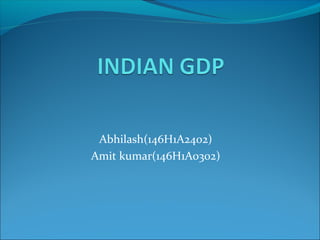Indian gdp by abhilash 3rd yr
- 2. INTRODUCTION • India’s economy is the 7th largest economy in the world in terms of market exchange rates.Since liberation of economy in 1991,the economy has towards market based system from a regulated and protected one.Now our India is the fastest growing economy in the world beating The Republic of China in 2014.Indian economy GDP rate is 7.4 as per 2014. • In 2007,Indian economy GDP has crossed over a trillon dollars which has made it one of the twelve trillon doller economic countries in the world. GDP COMPOSITION BY SECTORS- Services -57.9%; Agriculture -17.9% Industry -24.2% the above is as per 2014. NRI INSTITUTE OF TECHNOLOGY .--402 -302
- 4. Methods for calculating GDP These 3 ways are generally preffered ď‚— production approach ď‚—Income approach ď‚—Expenditure approach . -402 -302
- 5. Production approach • GDP=OP-IC+TP-SP. • OP - Output; • IC - Intermediate consumption; • TP- Taxes on products; • SP- Subsidies on products. . NRI INSTITUTE OF TECHNOLOGY . -402 _302
- 6. Income approach GDP=R+I+P+SA+W R –Rents; I-Interests; P-profits; S-statestical adjectives; W-wages. . NRI INSTITUTE OF TECHNOLOGY . -402 -302
- 7. Expenditure approach ď‚—GDP=C+I+GE+(X-M) ď‚—C - Consumption; ď‚—I - investment; ď‚—GE - government expenditure; ď‚—X - Exports; ď‚—M - Imports. . NRI INSTITUTE OF TECHNOLOGY . -402 -302
- 10. . 02 August 2008 10General: AV
- 11. CONCLUSION NRI INSTITUE OF TECHNOLOGY . -402 -302
- 12. THANK YOU :) ď‚—Harish MBA(MEFA) ď‚—FACULITIES ď‚—MY FELLOW NRI-TIANS Nri institute of technology -402 -302 .
Editor's Notes
- India’s Economic Growth: From Socialist Rate of Growth to Bharatiya Rate of Growth, Working Paper No. 122, ICRIER, February 2004. Propelling India from Socialist Stagnation to Global Power: Growth Process, Vol. I (Policy Reform, Vol. II), Academic Foundation, New Delhi, 2006. Policy Regimes, Growth and Poverty in India: Lessons of Government Failure and Entrepreneurial Success!, Working Paper No. 170, ICRIER, October 2005. “The Dynamics of Competition: Phasing of Domestic and External Liberalisation in India,” Working Paper No. 4/2006-PC, Planning Commission, April 2006.
- India’s Economic Growth: From Socialist Rate of Growth to Bharatiya Rate of Growth, Working Paper No. 122, ICRIER, February 2004. Propelling India from Socialist Stagnation to Global Power: Growth Process, Vol. I (Policy Reform, Vol. II), Academic Foundation, New Delhi, 2006. Policy Regimes, Growth and Poverty in India: Lessons of Government Failure and Entrepreneurial Success!, Working Paper No. 170, ICRIER, October 2005. “The Dynamics of Competition: Phasing of Domestic and External Liberalisation in India,” Working Paper No. 4/2006-PC, Planning Commission, April 2006.
- Related to next three figures
- Year 2005 2006 2007 Fdi Net $4.7 8.4 9.4 bi Inward $7.7 19.4 22.1 bi Outward $2.9 11.0 12.7 bi











